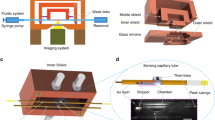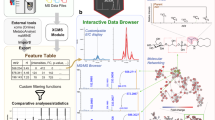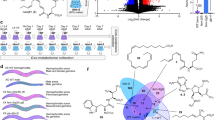Abstract
A crucial issue in comparative proteomics is the accurate quantification of differences in protein expression levels. To achieve this, several methods have been developed in which proteins are labeled with stable isotopes either in vivo via metabolic labeling or in vitro by protein derivatization. Although metabolic labeling is the only way to obtain labeling of all proteins, it has thus far only been applied to single- celled organisms1,2 and cells in culture2,3. Here we describe quantitative 15N metabolic labeling of the multicellular organisms Caenorhabditis elegans, a nematode, and Drosophila melanogaster, the common fruit fly, achieved by feeding them on 15N-labeled Escherichia coli and yeast, respectively. The relative abundance of individual proteins obtained from different samples can then be determined by mass spectrometry (MS). The applicability of the method is exemplified by the comparison of protein expression levels in two C. elegans strains, one with and one without a germ line. The methodology described provides tools for accurate quantitative proteomic studies in these model organisms.
This is a preview of subscription content, access via your institution
Access options
Subscribe to this journal
Receive 12 print issues and online access
$209.00 per year
only $17.42 per issue
Buy this article
- Purchase on Springer Link
- Instant access to full article PDF
Prices may be subject to local taxes which are calculated during checkout



Similar content being viewed by others
References
Oda, Y., Huang, K., Cross, F.R., Cowburn, D. & Chait, B.T. Accurate quantitation of protein expression and site-specific phosphorylation. Proc. Natl. Acad. Sci. USA 96, 6591–6596 (1999).
Conrads, T.P. et al. Quantitative analysis of bacterial and mammalian proteomes using a combination of cysteine affinity tags and 15N-metabolic labeling. Anal. Chem. 73, 2132–2139 (2001).
Ong, S.E. et al. Stable isotope labeling by amino acids in cell culture, SILAC, as a simple and accurate approach to expression proteomics. Mol. Cell. Proteomics 1, 376–386 (2002).
Beanan, M.J. & Strome, S. Characterization of a germ-line proliferation mutation in C. elegans. Development 116, 755–766 (1992).
Fire, A. et al. Potent and specific genetic interference by double-stranded RNA in Caenorhabditis elegans. Nature 391, 806–811 (1998).
Reinke, V. et al. A global profile of germline gene expression in C. elegans. Mol. Cell 6, 605–616 (2000).
Zhang, R. & Regnier, F.E. Minimizing resolution of isotopically coded peptides in comparative proteomics. J. Proteome Res. 1, 139–147 (2002).
Gygi, S.P. et al. Quantitative analysis of complex protein mixtures using isotope-coded affinity tags. Nat. Biotechnol. 17, 994–999 (1999).
Arbeitman, M.N. et al. Gene expression during the life cycle of Drosophila melanogaster. Science 297, 2270–2275 (2002).
Blagoev, B. et al. A proteomics strategy to elucidate functional protein-protein interactions applied to EGF signaling. Nat. Biotechnol. 21, 315–318 (2003).
Meiring, H.D. et al. Nanoscale LC-MS(n): technical design and applications to peptide and protein analysis. J. Sep. Sci. 25, 557–568 (2002).
Schagger, H. & von Jagow, G. Tricine-sodium dodecyl sulfate-polyacrylamide gel electrophoresis for the separation of proteins in the range from 1 to 100 kDa. Anal. Biochem. 166, 368–379 (1987).
Coates, P.J. The prohibitin family of mitochondrial proteins regulate replicative lifespan. Current Biology 7, 607–610 (1997).
Author information
Authors and Affiliations
Corresponding author
Ethics declarations
Competing interests
The authors declare no competing financial interests.
Rights and permissions
About this article
Cite this article
Krijgsveld, J., Ketting, R., Mahmoudi, T. et al. Metabolic labeling of C. elegans and D. melanogaster for quantitative proteomics. Nat Biotechnol 21, 927–931 (2003). https://doi.org/10.1038/nbt848
Received:
Accepted:
Published:
Issue Date:
DOI: https://doi.org/10.1038/nbt848
This article is cited by
-
Drosophila oocyte proteome composition covaries with female mating status
Scientific Reports (2021)
-
Sub-nanowatt resolution direct calorimetry for probing real-time metabolic activity of individual C. elegans worms
Nature Communications (2020)
-
Proteomic analysis in the model organism Daphnia has the potential to unravel molecular pathways involved in phenotypic changes in response to changing environmental conditions
Hydrobiologia (2019)
-
Absolute Quantitation of Oxidizable Peptides by Coulometric Mass Spectrometry
Journal of the American Society for Mass Spectrometry (2019)



